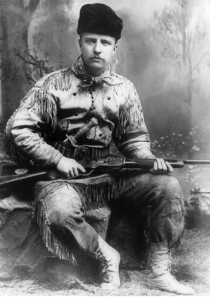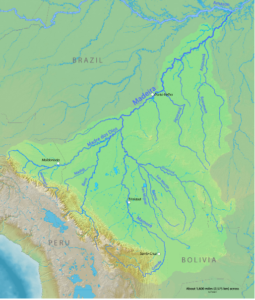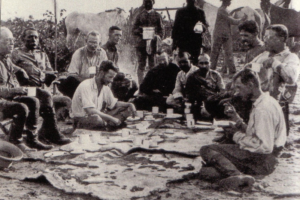
 Theodore Roosevelt’s Amazonian Expedition
Theodore Roosevelt’s Amazonian Expedition
In 1913-1914 Theodore Roosevelt embarked on a tour around the Amazon River Basin. Both Central and South America made up mostly of the Spanish colonies which were followed by the Portuguese and others. The United States came out victorious and for the first time the Monroe Doctrine can come into play. The Monroe Doctrine was an American policy issued by James Monroe. The policy commanded that no Europeans can colonize the American continent. This would leave the United States having the sole direct influence on the continent.
At that time during the 19th century it was not in play since the U.S. wasn’t on that level for hegemony. Meanwhile at the end of the 19th century began the recovery of the civil war which ravaged the country for four years, the U.S. was finally in a position to expander their horizons. In contemporary times James Monroe is still the boogey man in Latin America. Especially for Brazilians they felt inferiority and humiliated as well as degrading. With the commencement with the Spanish-American war the Monroe’s dream was realized. The Dream to establish direct U.S. influence on the entire western hemisphere.
Near his final years he had interest in the Amazonian basin and he wanted to partake in the navigation and make collections of exotic breeds and plants into the national zoo. At that time Roosevelt lost the elections and was hoping to make an enduring legacy. He wanted to navigate the so-called River of Doubt which was very dangerous and was uncharted. He would make himself as the first to navigate and chart the river other aside from the native non-European inhabitants. The River had a lot of predators in which the expedition became very risky going to uncharted areas. He hoped by going he can make an enduring name both in that region and home.
His closest companion Rondon was interested in bringing civilization to his homeland. “I want to bring Civilization which I have acquired to my Mato Grosso and my Amazonia” he said. He hoped that Roosevelt, president of the United States would be the job to do that. One can also say that Theodore wanted to make a new image of a typical white American male as ambitious or adventurous. In fact Roosevelt his hailed as the new image of what a white male out to represent.
What also added to his reputation as daring is that the so called River of doubt had been attempted to navigate before with Candido Rondon and his crew but was unsuccessful in the enterprise. Candido Rondon was a staunch supporter of Brazilians indigenous population; as a matter of fact his mother is of Amerindian Stock while his father is Portuguese. He remained in service for the Brazilian army most of his remaining life and worked to make his country a better place
At a young age Theodore Roosevelt became interested in natural science and wanted to collect exotic Flora and Fauna abroad in which Brazil provided all of it. Even today there are still species that haven’t been identified in the Amazon rich which hosts a huge diversity of various species such as fishes, predators, insects, birds, and reptiles.
Roosevelt also hoped that by setting up a natural museum he can help project the United States as the center of civilization and culture. The person who would encourage and recommend Roosevelt for the Amazonian adventure is John Augustine Zahm the priest.
According to the article by Bruce Fehn, the image of masculinity in the United States was deferent before as of now. That is due mainly because Theodore Roosevelt became the role model since he worked out and was muscular. In his adventure in the Amazonian river and into the uncharted “River of Doubt” would become his most undaunted task were white American males of his day and after would attempt to strive to emulate his image.
Having a huge popularity at that time little children would have their bear toys would be called after him, hence “teddy” from the nickname for Theodore would bring us the Teddy Bear. Out of love for the nature he was against poaching and he got applauded and praises for saving a grizzly bear from slow and painful death in spite of his colleagues proposal to hunt it, which he deemed sportsmanship.
The Brazilian government was warm and kind, for they recommended to him to search out the River of Doubt that is about 1000-mile long. Before he wanted to just visit Brazil and other South American countries. The Expedition turned out completely successful, but with the tragic death of three companions.
As will be explained later on, Roosevelt almost lost his life but miraculously managed to survive and continue the journey. His son Kermit Roosevelt initially did not desire to participate but his mother persuaded him to go in order to protect his father against the dangers ahead. Kermit would also be one of the few of the original who remained with his dad in the uncharted River of doubt.
The Brazilians (aside from Candino Rondon) who would assist Roosevelt and his party were strong ambitious men and optimistic. Nevertheless they considered the territory of the River of doubt too difficult and too dangerous. It is said that only few a few of the native Brazilian tribesmen had ventured there.
Candido Rondon is known to have been around the area and if it had to be anyone of interest, it is he that Theodore Roosevelt would depend upon and trust for an audacious enterprise. After all he has been disciplined in the army for a lot of years in hardships and all physical challenges in which the terrain of Brazil offers.
As the expedition dragged on for months, his son Kermit communicated with his wife Belle Willard via letter of his hardships. His letter exclaimed that “He missed civilization”, and his missed his love Belle, and he feared for his father’s well being, and mostly the fear that gotten in over his head- a situation for which he blamed on Father Zahm, the priest who recommended the idea to explore in the first place.
Kermit refused to go abroad the so called ‘Nyoac’ which is the boat the party boarded on. Meanwhile the companions were curious about Theodore Roosevelt not just because of being an ex-president but his adventures. They were impressed and astonished that he was very mannered and warm heated. On the other hand, he was way more interested in hearing about their achievements and ambitions than in talking about his own.
At age 55 Roosevelt prevailed against the extreme tests of physical endurance, but he relished them to the annoyance of those who were unfortunate enough to be along for the ride. Roosevelt made an huge impression during the Jaguar hunt which turned emblematic among the companions on board the Nyoac, ascribed him with awe after the former president prevailed against the wild beasts.
When that day passed, it was astonishing how when they party returned to camp after the Jaguar hunt. Theodore was with his son Kermit and still energetic as if it was a regular day, it was the Brazilians who were exhausted and rested for two days. The people had nothing but respect for Roosevelt.
In the beginning Roosevelt had thought that in this expedition he would be taking this would become his ‘last chance to be a boy.’ Before he left the United States he was warned of the upcoming danger in which out of pride he remarked that if he has to leave his corpse in South America then he would and he was ready to do so. As shown he was prepared since he was experience in wild life.
The real dangers ahead were on the river were their wooden boats or canoes were threated by alligators which can break the boat if left idle. Piranha’s are also predominate which jump and bite.
Another huge irritant during the journey were flies and mosquitoes that was everywhere and worse of all if when they are camping. Theodore Roosevelt was bitten by a venous coral snake which kills but luckily wearing thick boots h survived the bite as it did not penetrate his skin. At first the journey went smoothly as long as the river rapids were not strong.
Whenever the current were fierce the party had to disembark and carry the boats overland until the waters are calm. It took a lot of miles (varying on circumstances) and new canoes had to be built since the old ones got destroyed due to crossing or breaking. Another obstacle on the rivers were whirlpools in which Kermit’s canoe got itself trapped into one and he had to jump off and swim to get on the bank. The two others who were with him, one was able to escape while the other who was Brazilian drowned.
Adding to the troubles were the various Indian tribes that were hostile to foreigners since they remained unexposed to urban life around. The party knew they were being stalked and exposed to ambush. Candino Rondon lost his dog to an Indian arrow but when they came face to face the native allowed the party to trespass unharmed.
The problems was far from over, the farther the expedition went, being under constant harassment by the mosquitoes they got exposed to malaria. It was a heavy toll in which logistics were running and dysentery was rampart. It all got desperate when one of the Brazilians got killed for attempting to steal food from another. The killer escaped and abandoned the expedition.
But the time the crew was about 19 members the main focus became more about survival then rather a scientific search or a safari. Theodore Roosevelt remained the strongest and he told the crew that he didn’t mind to die; he also suggested that they should continue the journey without him.
When Roosevelt got his leg cut into a rock he got infected and had a harsh fever. They had doubts that he can survive until his son Kermit refused to leave him behind and helped his father. Roosevelt lost a lot of weight and an estimate 10 years of his life, while being treated for his legs; he had to be left in the canoe resting while Rondon continued the expedition.
The river of doubt was successfully navigated though with casualties but finally they made it out and reached the nearby towns. Roosevelt still had immense pride and boasted on the Brazilian radio of how hard but successful the journey took him.
He returned home back in May 1914 where he was given the highest praises. The Brazilians on the other hand renamed the river ‘Roosevelt River’ in honor of his memory. He still remained sick because of the Brazilian wildlife and would eventually stay aside from the public.
“I don’t go so far as to think that the only good Indians are the dead Indians, but I believe nine out of every 10 are,”

From left to right (seated): Fr. John Augustine Zahm, Cândido Rondon, Kermit Roosevelt, Cherrie, Miller, four Brazilians, Roosevelt, Fiala. Only Roosevelt, Kermit, Cherrie, Rondon, and the Brazilians traveled down the River of Doubt.